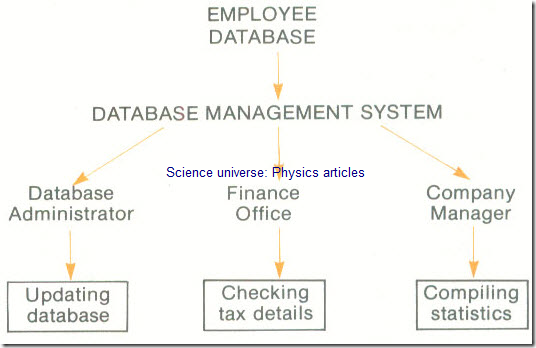Databases and Data Banks
A database is a large collection of data structured in such a way that it can be used in different ways for different applications.
A database management system (DBMS) is a set of programs which organizes the use of a database. (See Fig 3)
Fig 3 Example of a database management system-the database contains details of employees of a company. The diagram shows only 3 of many applications which use the database
The database management system allows the different users to work independently of one another. Its main functions are:
1 To enable users to access the data they require as easily as possible.
2 To allow the database to be updated.
3 To control security, so that individual users can only access data and facilities for which they are authorized.
Often a database system will have its own language. This will allow users to write enquiries easily to retrieve specific information and/or to produce statistics and graphs from the database.
Data bank is not a closely defined term but refers to a library of data files and or databases.
Notes: The term database is sometimes used rather loosely:
1 Large simple files are of Len referred to as databases.
2 Simple file enquiry programs for microcomputers are often called database packages. All these programs usually do is to allow the user to create files and to retrieve selected data from them using simple commands.
Example of a database and a data bank
A school stores data about its pupils recording their names, classes, dates of birth, addresses and the subjects they are taking. It also stores data about the use of rooms and the timetable and this data is all linked together to from a database.
Programs using the database include ones to:
1 Print out the whole school list in alphabetical order.
2 Prepare class lists for the teachers.
3 Find out how many pupils are in various age ranges.
4 Work out the number of chairs and tables required in each room.
5 Produce statistics about the numbers of pupils in the 4th year opting for different subjects.
The school also has separate files stored on the same computer containing its tuck shop accounts and details of its stock of library books. All of this data taken together forms a data bank.

